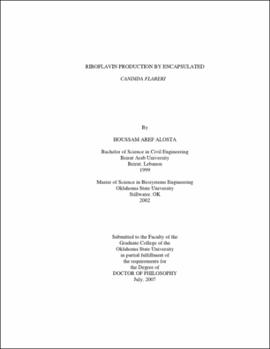| dc.contributor.advisor | Bellmer, Danielle | |
| dc.contributor.author | Alosta, Houssam A. | |
| dc.date.accessioned | 2013-11-26T07:43:10Z | |
| dc.date.available | 2013-11-26T07:43:10Z | |
| dc.date.issued | 2007-07 | |
| dc.identifier.uri | https://hdl.handle.net/11244/6400 | |
| dc.description.abstract | Scope and Method of Study: Calcium alginate capsules were used for entrapment of the yeast Candida flareri for riboflavin production. The first goal was to evaluate the addition of nonionic surfactants to the capsule membrane. The diffusion coefficients of glucose and riboflavin through the hollow capsules were then evaluated by monitoring the change in solute concentration in the bulk solution. The second goal was to evaluate the performance of the immobilized yeast in continuous bioreactors producing riboflavin. Fermentation efficiencies of three immobilized systems and a suspended growth system were compared. The immobilized systems included a control (calcium alginate capsules made without surfactants), a system with capsules made with the addition of Span 85 (HLB 1.8), and a system with capsules made with the addition of Tween 20 (HLB 16.7). | |
| dc.description.abstract | Findings and Conclusions: Results indicate that the addition of surfactants that are more oil soluble (low hydrophile-lipophile balance, HLB) during capsule preparation increased the diffusion coefficient of riboflavin away from capsules, while the addition of surfactants that are more water soluble (high HLB) increased the diffusion coefficient of glucose into the capsules. Their addition may have rendered the membrane more permeable by making the capsules more porous, thus increasing solute diffusion. The application of immobilized continuous riboflavin production techniques resulted in increased riboflavin productivity compared to the suspended growth system. Two of the immobilized systems contained capsules made with nonionic surfactants. Results showed that immobilized systems containing surfactant-modified capsules resulted in greater productivity than the control system (containing capsules made without surfactants). Results show great promise for the continuous immobilized cell reactor for riboflavin production using capsules made with nonionic surfactants. | |
| dc.format | application/pdf | |
| dc.language | en_US | |
| dc.rights | Copyright is held by the author who has granted the Oklahoma State University Library the non-exclusive right to share this material in its institutional repository. Contact Digital Library Services at lib-dls@okstate.edu or 405-744-9161 for the permission policy on the use, reproduction or distribution of this material. | |
| dc.title | Riboflavin production by encapsulated Candida flareri | |
| dc.contributor.committeeMember | Wilkins, Mark Robert | |
| dc.contributor.committeeMember | Clarkson, William W. | |
| dc.contributor.committeeMember | Fathepure, Babu Z. | |
| osu.filename | Alosta_okstate_0664D_2346 | |
| osu.accesstype | Open Access | |
| dc.type.genre | Dissertation | |
| dc.type.material | Text | |
| dc.subject.keywords | biosystem | |
| dc.subject.keywords | bioprocess | |
| thesis.degree.discipline | Biosystems and Agricultural Engineering | |
| thesis.degree.grantor | Oklahoma State University | |
